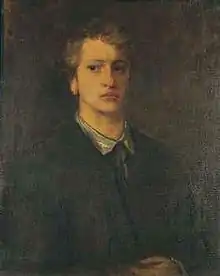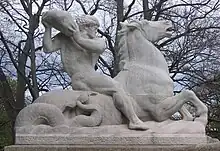Adolf von Hildebrand
Adolf von Hildebrand (6 October 1847 – 18 January 1921) was a German sculptor.
Adolf von Hildebrand | |
|---|---|
 Hans von Marées, Portrait of the sculptor Adolf von Hildebrand | |
| Born | 6 October 1847 |
| Died | 18 January 1921 |
| Resting place | Kirchhof Oberföhring, Oberfohring, Münchener Stadtkreis, Bavaria (Bayern), Germany |
| Education | Academy of Fine Arts, Nuremberg, Academy of Fine Arts, Munich |

Life

Hildebrand was born at Marburg, the son of Marburg economics professor Bruno Hildebrand. He studied at the Academy of Fine Arts Nuremberg, with Kaspar von Zumbusch at the Munich Academy and with Rudolf Siemering in Berlin.[1] From 1873 he lived in Florence in the St Francesco Monastery, a secularized sixteenth-century monastery.
A friend of Hans von Marées, he designed the architectural setting for the painter's murals in the library of the German Marine Zoological Institute at Naples (1873).[2] He spent a significant amount of time in Munich after 1889, executing a monumental fountain there, the Wittelsbacher Brunnen. He is known for five monumental urban fountains and for the Bismarck monument in Bremen, unveiled in 1910.
Hildebrand worked in a Neo-classical tradition, and set out his artistic theories in his book Das Problem der Form in der Bildenden Kunst ("The Problem of Form in Painting and Sculpture"), published in 1893.[3]
He was ennobled by the King of Bavaria in 1904.
He died in Munich in 1921.
Family
In 1877 he married Irene Schäuffelen. They were parents of the painter Eva, Elizabeth, sculptor Irene Georgii-Hildebrand, Sylvie, Bertele, and Catholic theologian Dietrich von Hildebrand.
Critical opinion
In 1917, the American sculptor, conservative critic and author Lorado Taft, while bemoaning the direction the German sculpture was moving in, described Hildebrand as:
a master of the old school and Florentine tradition, whose example has been a constant gospel of good taste and sanity. Even today, when the whole world has gone after false gods, his influence continues to be felt and I wonder if the fact that in the midst of this revolution German sculpture, however fantastic, remains essentially sculpture, is not due largely to the life long precept and practice of this admirable representative of the craft.[4]
References
- McKay, James (1995). The Dictionary of Sculptors in Bronze. London: Antique Collectors Club.
- German Masters of the Nineteenth Century: Paintings and Drawings from the Federal Republic of Germany (Catalogue of an exhibition held at the Metropolitan Museum of Art). New York. 1981.
{{cite book}}: CS1 maint: location missing publisher (link) Free download available. - Novotny, Fritz (1988) [1960]. Painting and Sculpture in Europe. The Pelican History of Art. Harmondsworth: Penguin Books. p. 413. ISBN 014056120X.
- Taft, Lorado, ‘’Modern Tendencies in Sculpture: The Scammon Lectures at the Art Institute of Chicago, 1917’’ University of Chicago Press, Chicago, Illinois, 1922 p. 53-54
- World Wide Art Resources
- Dietrich von Hildebrand: the Soul of a Lion, by Alice von Hildebrand (Ignatius, 2000)
- Adolph von Hildebrand page
- Encyclopædia Britannica Vol. 11, pp 491–492 (1971) ISBN 0-85229-151-5